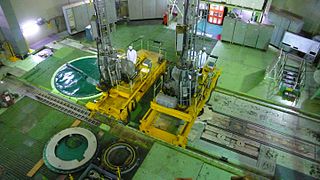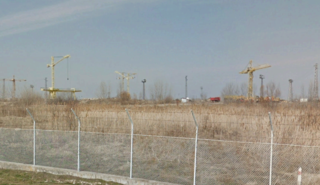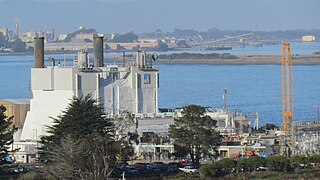Related Research Articles

The pebble-bed reactor (PBR) is a design for a graphite-moderated, gas-cooled nuclear reactor. It is a type of very-high-temperature reactor (VHTR), one of the six classes of nuclear reactors in the Generation IV initiative.

Dry cask storage is a method of storing high-level radioactive waste, such as spent nuclear fuel that has already been cooled in the spent fuel pool for at least one year and often as much as ten years. Casks are typically steel cylinders that are either welded or bolted closed. The fuel rods inside are surrounded by inert gas. Ideally, the steel cylinder provides leak-tight containment of the spent fuel. Each cylinder is surrounded by additional steel, concrete, or other material to provide radiation shielding to workers and members of the public.

The Ignalina Nuclear Power Plant is a decommissioned two-unit RBMK-1500 nuclear power station in Visaginas Municipality, Lithuania. It was named after the nearby city of Ignalina. Due to the plant's similarities to the infamous Chernobyl Nuclear Power Plant in both reactor design and lack of a robust containment building, Lithuania agreed to close the plant as part of its accession agreement to the European Union. Unit 1 was closed in December 2004; Unit 2, which counted for 25% of Lithuania's electricity generating capacity and supplied about 70% of Lithuania's electrical demand, was closed on December 31, 2009. Proposals have been made to construct a new nuclear power plant at the same site, but plans have not materialised since then.

The Kozloduy Nuclear Power Plant is a nuclear power plant in Bulgaria situated 180 kilometres (110 mi) north of Sofia and 5 kilometres (3.1 mi) east of Kozloduy, a town on the Danube river, near the border with Romania. It is the country's only nuclear power plant and the largest in the region. The construction of the first reactor began on 6 April 1970.

The New Safe Confinement is a structure put in place in 2016 to confine the remains of the number 4 reactor unit at the Chernobyl Nuclear Power Plant, in Ukraine, which was destroyed during the Chernobyl disaster in 1986. The structure also encloses the temporary Shelter Structure (sarcophagus) that was built around the reactor immediately after the disaster. The New Safe Confinement is designed to prevent the release of radioactive contaminants, protect the reactor from external influence, facilitate the disassembly and decommissioning of the reactor, and prevent water intrusion.

Madras Atomic Power Station (MAPS) located at Kalpakkam about 80 kilometres (50 mi) south of Chennai, India, is a comprehensive nuclear power production, fuel reprocessing, and waste treatment facility that includes plutonium fuel fabrication for fast breeder reactors (FBRs). It is also India's first fully indigenously constructed nuclear power station, with two units each generating 220 MW of electricity. The first and second units of the station went critical in 1983 and 1985, respectively. The station has reactors housed in a reactor building with double shell containment improving protection also in the case of a loss-of-coolant accident. An Interim Storage Facility (ISF) is also located in Kalpakkam.

The BN-350 is a sodium-cooled, fast reactor located at the Mangyshlak Nuclear Power Plant, located in Aktau, Kazakhstan, on the shore of the Caspian Sea.

Yankee Rowe Nuclear Power Station was a nuclear power plant in Rowe, Massachusetts, located on the Deerfield River in the town of Rowe in western Massachusetts. Its 180 MWe pressurized water reactor operated from 1961 to 1991. It produced electricity for New England consumers. The site is referred to as "Yankee-Rowe" or simply "Rowe", to avoid confusion with Vermont Yankee, another nuclear power station located in nearby Vernon, Vermont. The decommissioning of the site was completed in 2007.

Nuclear decommissioning is the process leading to the irreversible complete or partial closure of a nuclear facility, usually a nuclear reactor, with the ultimate aim at termination of the operating licence. The process usually runs according to a decommissioning plan, including the whole or partial dismantling and decontamination of the facility, ideally resulting in restoration of the environment up to greenfield status. The decommissioning plan is fulfilled when the approved end state of the facility has been reached.

The Belene Nuclear Power Plant is a planned nuclear power plant 3 km from Belene and 11 km from Svishtov in Pleven Province, northern Bulgaria, near the Danube River. It was intended to substitute four VVER-440 V230 reactors of the Kozloduy Nuclear Power Plant that were decommissioned as a prerequisite for Bulgaria to join the European Union.

The Borssele Nuclear Power Station is a nuclear power plant near the Dutch town of Borssele. It has a pressurised water reactor (PWR). Borssele is the only nuclear power plant still operational for electricity production in the Netherlands. Its net output is 485 MWe.

Berkeley nuclear power station is a decommissioned Magnox nuclear power station situated on the bank of the River Severn in Gloucestershire, England. The ongoing decommissioning process is being managed by Nuclear Decommissioning Authority subsidiary Magnox Ltd.
Atomstroyexport is the Russian Federation's nuclear power equipment and service exporter. It is a fully owned subsidiary of Rosatom. The activities of Atomstroyexport are financially supported by the Russian government. The President of ASE Group of Companies is Alexander Lokshin.

The Astravets Nuclear Power Plant is a nuclear power plant located in the Astravyets District, Grodno Region in north-western Belarus. The power plant is built close to the Belarus-Lithuania border, being 40 kilometres (25 mi) east of the Lithuanian capital of Vilnius. The plant is powered by a 1194-MW VVER-1200 unit supplied by Atomstroyexport, the nuclear equipment exporter branch of the Russian nuclear corporation Rosatom. Another 1194-MW VVER-1200 unit is under construction. The plant is owned by State Enterprise Belarusian NPP, which in turn is owned by the state-owned operator Belenergo.

The Humboldt Bay Power Plant, Unit 3 was a 63 MWe nuclear boiling water reactor, owned by Pacific Gas and Electric Company that operated from August 1963 to July 1976 just south of Eureka, California.
Nuclear power in the European Union accounted for approximately 26% of total electricity production in 2019 and nearly half of low-carbon energy production across the EU.

High-level radioactive waste management concerns how radioactive materials created during production of nuclear power and nuclear weapons are dealt with. Radioactive waste contains a mixture of short-lived and long-lived nuclides, as well as non-radioactive nuclides. There was reportedly some 47,000 tonnes of high-level nuclear waste stored in the United States in 2002.
Lithuania does not have any operational nuclear power reactor. It operated two RBMK reactors at Ignalina nuclear power plant which were shut down in 2004 and 2009.
Nukem GmbH, together with its subsidiary Nukem Inc., markets nuclear fuel components and speciality products utilities worldwide. Since the 1970s, Nukem has transitioned from playing a modest role in uranium brokerage to becoming one of the world's largest intermediaries in the international nuclear fuel market.

The Jinshan Nuclear Power Plant or Chin Shan Nuclear Power Plant (金山核能發電廠), First Nuclear Power Plant, is a nuclear power plant being definitely shutdown in Shimen District, New Taipei, Taiwan. Commissioned in 1978, the plant was Taiwan's first and smallest nuclear power plant.
References
- ↑ "Atomstroyexport buys NPP decommissioning technology". Kommersant . RIA Novosti. 2009-12-25. Archived from the original on January 5, 2010. Retrieved 2009-12-26.
- ↑ "Nukem Technologies now owned by ASE". World Nuclear News . 2009-12-15. Retrieved 2012-10-07.
- ↑ "Construction go-ahead for Ignalina waste stores". World Nuclear News . 2009-09-03. Retrieved 2012-10-07.
- ↑ "Lithuania has problems disassembling the old Ignalina power plant". CE Weekly. Centre for Eastern Studies. 2010-05-26. Archived from the original on 2012-04-01. Retrieved 2012-10-07.
- ↑ Hyndle-Hussein, Joanna (2011-09-14). "Lithuania: Problems with decommissioning of the Ignalina Nuclear Power Plant". CE Weekly. Centre for Eastern Studies . Retrieved 2012-10-07.
- ↑ "Nukem awarded contract at PBMR fuel plant". World Nuclear News . 2007-08-13. Retrieved 2012-10-07.